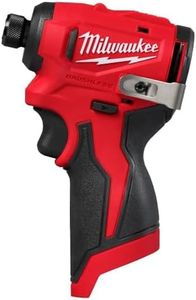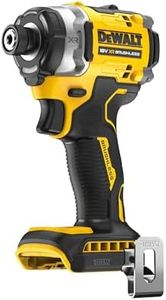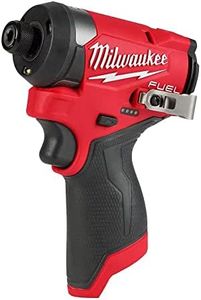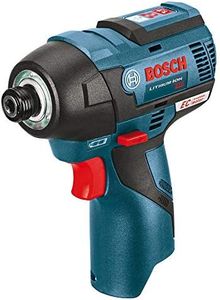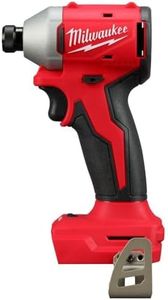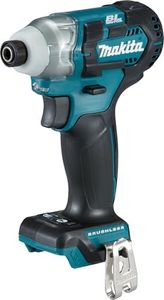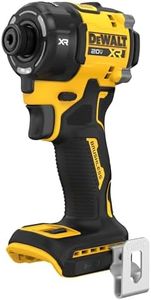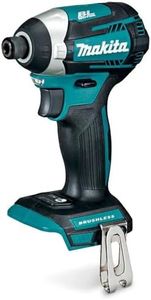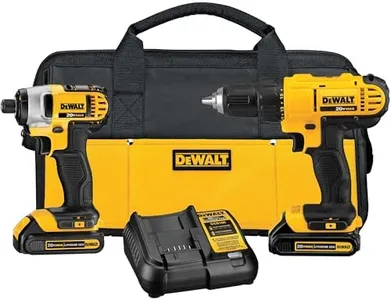We Use CookiesWe use cookies to enhance the security, performance,
functionality and for analytical and promotional activities. By continuing to browse this site you
are agreeing to our privacy policy
10 Best Cordless Impact Drivers
From leading brands and best sellers available on the web.Buying Guide for the Best Cordless Impact Drivers
Choosing the right cordless impact driver can make a huge difference in how easily and effectively you can complete a range of tasks, from furniture assembly to construction projects. The best fit for you depends on understanding the kinds of jobs you expect to do, your preferences for comfort and portability, and how much power you really need. Learning about the main features will help you confidently identify which impact driver is best for your needs.VoltageVoltage refers to the battery power supplied to the impact driver and is a key indicator of its overall performance and strength. Typically, cordless impact drivers come in voltages like 12V, 18V, or 20V. Lower voltages, such as 12V, make for lighter and more compact tools, ideal for light-duty tasks and working in tight spaces. Higher voltages, like 18V or 20V, provide more torque and runtime for heavy-duty applications such as driving large screws into hardwood or construction work. Consider the type of work you most often do; lighter jobs need less voltage, while demanding tasks benefit from more power.
TorqueTorque measures the twisting force that the impact driver can deliver, usually listed in inch-pounds (in-lbs) or Newton-meters (Nm). More torque means more power to drive long or thick fasteners into tough materials without bogging down. Lighter tasks or soft materials only need moderate torque, so a lower rating is enough for assembly or household use. For heavier construction, decking, or automotive work, go for higher torque ratings to ensure the driver can handle stubborn screws or bolts with ease.
Impacts Per Minute (IPM)IPM tells you how many hammering actions the tool delivers each minute, which helps in loosening and tightening fasteners quickly and efficiently. A higher IPM means faster and more efficient fastening, which is especially useful when working with hard materials. For occasional or light-duty projects, a lower IPM will suffice, but for driving lots of screws or working with tough materials, choose a driver with a higher IPM.
Battery Capacity (Ah)Battery capacity is measured in ampere-hours (Ah) and tells you how long the tool can run before needing a recharge. Higher Ah batteries last longer on a single charge but also tend to be heavier. If you often work on longer projects or don’t want to stop and recharge, look for a higher capacity. If your jobs are brief or you have easy access to charging, a lower Ah battery will keep the tool lighter and more nimble.
Size and WeightThe overall size and weight of the impact driver impact how comfortable it is to use, especially for longer periods or in awkward positions. Compact and lightweight models are easier to handle and reduce fatigue, making them great for overhead work or people with smaller hands. Larger, heavier models may offer more power but can be cumbersome over time. Think about how long you’ll be holding the tool and whether you're often working overhead or in tight spots to find the right balance between strength and comfort.
Chuck Size and TypeCordless impact drivers typically use a 1/4-inch hex chuck that makes it quick and easy to swap bits. Some tools have more advanced or quick-release chucks for even smoother bit changes. If you plan to change bits frequently or want to use specialty bits, look for an easy-to-use chuck. For basic tasks, a standard 1/4-inch hex chuck is usually just fine.
Speed SettingsSome impact drivers offer variable speed settings or multiple presets, allowing you more control based on the specific job. More speed options help prevent overdriving screws and stripping fasteners on delicate projects, while high speed helps get through tough work quickly. If you work with a range of materials and fastener sizes, variable speed is very helpful, but for simple, repetitive tasks, a single speed might be enough.
Additional FeaturesOther convenient features can make a big difference in ease of use or versatility. Built-in LED lights help when working in dim spaces, belt clips make carrying easier, and brushes or brushless motors can affect tool life and efficiency. Think about whether features like lighting or motor type will be useful in your work environment to get the most value from your driver.

